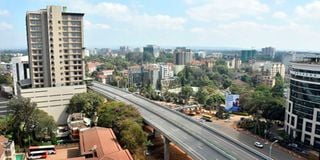Premium
Belt and Road Initiative will benefit President William Ruto

An aerial view of the Nairobi Expressway.
In mid-October, President William Ruto is expected to make his maiden visit to China to participate in the third summit to mark 10 years of the Belt and Road Initiative (BRI). As a protégé of former President Mwai Kibaki’s (2003–2013) economic transformative agenda, President Ruto will travel to China armed with his regime’s Bottom-Up Economic Transformation Agenda (BETA). Anchored on the pillars of agriculture; micro, small, and medium enterprise economy; healthcare; housing and settlement; digital superhighway and creative economy; environment and climate change, President Ruto could revolutionise the country if he aligns his agenda with the five pillars of BRI (policy coordination, infrastructure development, trade promotion, financial connectivity, and people-to-people bonds).As Arthur M Schlesinger Jr, an American historian and social critic, observed “It is useful to remember that history is to the nation as memory is to the individual. As a person deprived of memory becomes disoriented and lost, not knowing where they have been or where they are going, so a nation denied a conception of the past will be disabled in dealing with its present and its future.”This quote needs to trigger President Ruto’s memory of why and how Mr Kibaki transformed Kenya into an economic hub in East Africa. Kibaki’s ‘Look East Policy’ was his magic wand. Thus, as President Ruto visits Beijing, he should reflect on how strategic partnerships are key to achieving the goals of BETA.The impact of the BRI in Kenya is visible. In 2013 when BRI was launched, Kenya’s GDP was $61.67 billion. This year as we mark the 10th anniversary of the BRI, Trading Economics projects Kenya’s GDP to reach $117.19 billion.This increase has been spurred by the infrastructure development. For instance, the Thika Superhighway has enhanced the urbanisation and development of new towns along the route.The Standard Gauge Railway (Mombasa-Nairobi-Naivasha) , a flagship project of Kenya’s Vision 2030 under the BRI, has revolutionised the transport sector. Its impact has been immense. The SGR created 46,000 jobs for the locals, boosted the urbanisation of 33 stations and centres along the route, and enhanced bilateral economic development.Since its launch in 2017, the SGR has transported some 30 million people. Similarly, the total freight service is more than 23 million tonnes.The two projects have improved the collecting-distributing system, enhanced market competitiveness in the region, improved cargo handling and transportation, promoted industrialisation and increased the growth of freight volume of Mombasa-Naivasha SGR. As a proof of concept, the SGR is a game-changer in Kenya’s development. However, as a public good, railways in advanced economies are not meant for profit. They are key embodiments of national development.Through BRI, the Nairobi Expressway, a 27-km toll road is a classic architecture demystifying the debt trap diplomacy narrative propagated against China’s ‘brick and mortar’ diplomacy. Thus, under the build, operate, and transfer (BOT) strategy, the Nairobi Expressway does not add to the country’s fiscal debt.The road expansions and the SGR are just but a small fraction of what the BRI has accomplished in Kenya. Today, through BRI, Kenya is enjoying the benefits of having various industries focusing on energy, agro-processing, machinery, engineering, construction, electronics, and ICT. For President Ruto’s administration to achieve its BETA, which is already within the larger BRI framework, they need to embrace the power of partnership, especially with China which has the means, ability and desire to continue modernising infrastructure.Dennis Munene is the Executive Director of the China-Africa Center.


